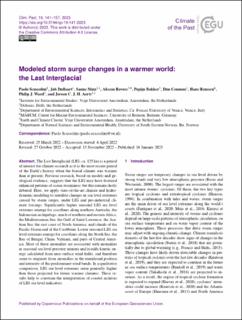| dc.contributor.author | Scussolini, Paolo | |
| dc.contributor.author | Dullaart, Job | |
| dc.contributor.author | Muis, Sanne | |
| dc.contributor.author | Rovere, Alessio | |
| dc.contributor.author | Bakker, Pepijn | |
| dc.contributor.author | Coumou, Dim | |
| dc.contributor.author | Renssen, Hans | |
| dc.contributor.author | Ward, Philip J. | |
| dc.contributor.author | Aerts, Jeroen C. J. H. | |
| dc.date.accessioned | 2023-11-03T14:19:51Z | |
| dc.date.available | 2023-11-03T14:19:51Z | |
| dc.date.created | 2023-03-21T13:28:34Z | |
| dc.date.issued | 2023 | |
| dc.identifier.citation | Scussolini, P., Dullaart, J., Muis, S., Rovere, A., Bakker, P., Coumou, D., Renssen, H., Ward, P. J. & Aerts, J. C. J. H. (2023). Modeled storm surge changes in a warmer world: the Last Interglacial. Clim. Past, 19(1), 141-157. | en_US |
| dc.identifier.issn | 1814-9324 | |
| dc.identifier.uri | https://hdl.handle.net/11250/3100581 | |
| dc.description.abstract | The Last Interglacial (LIG; ca. 125 ka) is a period of interest for climate research as it is the most recent period of the Earth's history when the boreal climate was warmer than at present. Previous research, based on models and geological evidence, suggests that the LIG may have featured enhanced patterns of ocean storminess, but this remains hotly debated. Here, we apply state-of-the-art climate and hydrodynamic modeling to simulate changes in sea level extremes caused by storm surges, under LIG and pre-industrial climate forcings. Significantly higher seasonal LIG sea level extremes emerge for coastlines along northern Australia, the Indonesian archipelago, much of northern and eastern Africa, the Mediterranean Sea, the Gulf of Saint Lawrence, the Arabian Sea, the east coast of North America, and islands of the Pacific Ocean and of the Caribbean. Lower seasonal LIG sea level extremes emerge for coastlines along the North Sea, the Bay of Bengal, China, Vietnam, and parts of Central America. Most of these anomalies are associated with anomalies in seasonal sea level pressure minima and in eddy kinetic energy calculated from near-surface wind fields, and therefore seem to originate from anomalies in the meridional position and intensity of the predominant wind bands. In a qualitative comparison, LIG sea level extremes seem generally higher than those projected for future warmer climates. These results help to constrain the interpretation of coastal archives of LIG sea level indicators. | en_US |
| dc.language.iso | eng | en_US |
| dc.rights | Navngivelse 4.0 Internasjonal | * |
| dc.rights.uri | http://creativecommons.org/licenses/by/4.0/deed.no | * |
| dc.title | Modeled storm surge changes in a warmer world: the Last Interglacial | en_US |
| dc.type | Peer reviewed | en_US |
| dc.type | Journal article | en_US |
| dc.description.version | publishedVersion | en_US |
| dc.rights.holder | © Author(s) 2023. | en_US |
| dc.source.pagenumber | 141-157 | en_US |
| dc.source.volume | 19 | en_US |
| dc.source.journal | Climate of the Past | en_US |
| dc.source.issue | 1 | en_US |
| dc.identifier.doi | https://doi.org/10.5194/cp-19-141-2023 | |
| dc.identifier.cristin | 2135796 | |
| cristin.ispublished | true | |
| cristin.fulltext | original | |
| cristin.qualitycode | 1 | |

